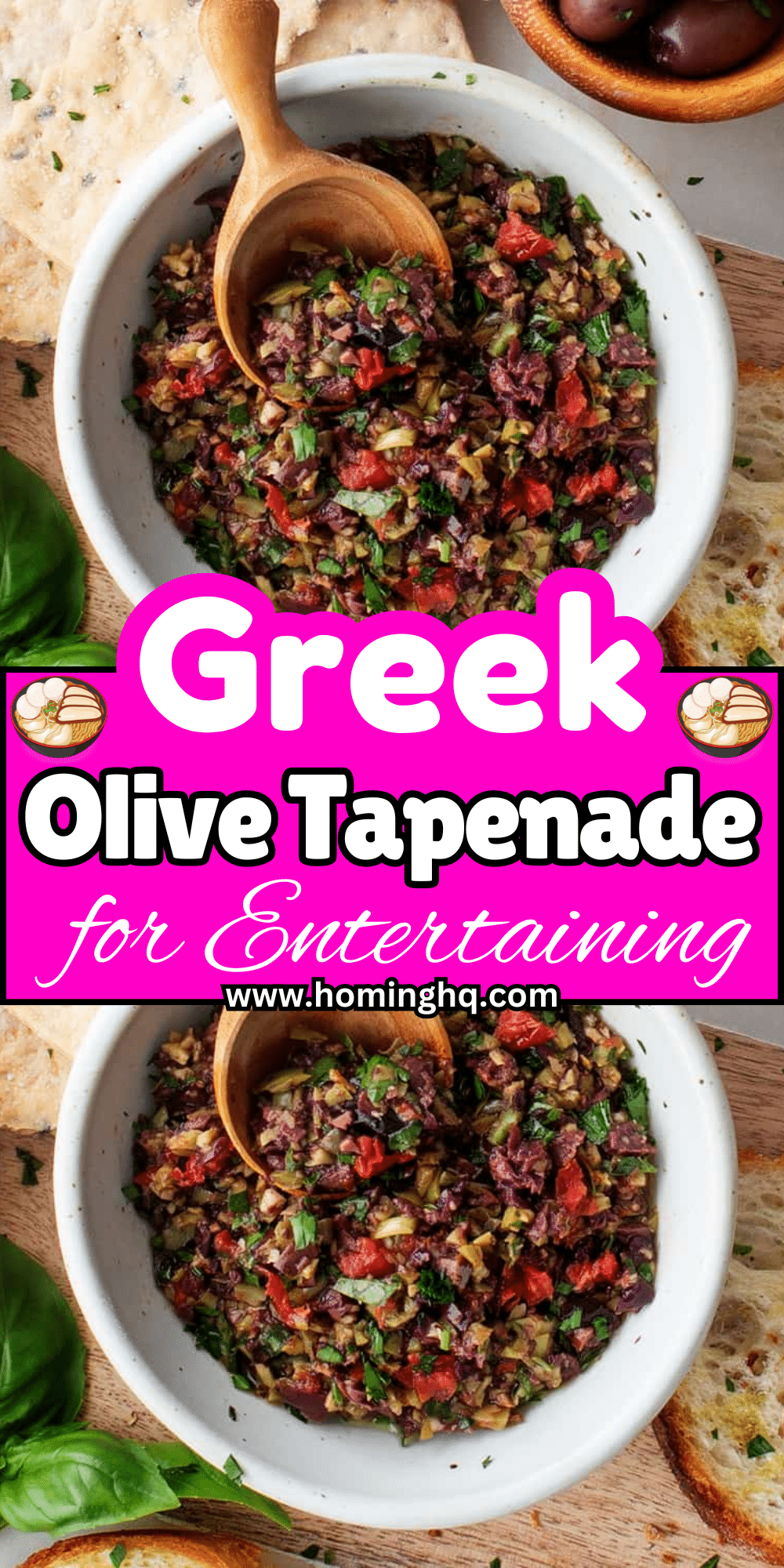All products are selected by our editorial team for quality. If you buy through our links, we may earn a small commission at no extra cost to you.
Greek Olive Tapenade is a classic Mediterranean spread that combines the rich flavors of olives, garlic, capers, and olive oil.
This vibrant dish is often served as an appetizer, dip, or condiment and has become a beloved part of Greek cuisine.
Whether spread over warm pita bread or paired with grilled meats, its bold and tangy taste always stands out.
Simple to prepare and packed with healthy ingredients, Greek Olive Tapenade is a perfect addition to any meal, offering a little taste of the Mediterranean with every bite.
In this post, we’ll explore the origins of this delicious spread, its health benefits, and how to make it yourself in the comfort of your kitchen.
Get ready to enjoy a savory, zesty treat that will impress your guests or add a burst of flavor to your everyday meals.

What is Greek Olive Tapenade?
Greek Olive Tapenade is a traditional Mediterranean dip made primarily from finely chopped olives, capers, garlic, olive oil, and various herbs.
The main ingredient—olives—gives tapenade its distinct briny, rich flavor.
While the recipe’s roots are firmly planted in southern France, Greece has its own take, often featuring Kalamata olives, which lend a unique depth and complexity to the dish.
This Mediterranean spread is versatile, with different versions depending on the region. Some recipes include anchovies, while others may omit them for a more plant-based version.
The resulting blend of savory, salty, and slightly tangy flavors makes Greek Olive Tapenade an irresistible accompaniment to bread, grilled meats, vegetables, and even pasta dishes.
Health Benefits of Greek Olive Tapenade
Greek Olive Tapenade isn’t just a flavorful treat—it’s also packed with nutritional benefits that contribute to overall health and well-being.
Here’s why adding this dish to your meals can be a healthy choice:
Rich in Antioxidants and Healthy Fats
Olives and olive oil, the key ingredients in tapenade, are excellent sources of antioxidants, which help protect your body from oxidative stress and free radical damage.
Olive oil, in particular, is rich in monounsaturated fats, which have been linked to improved heart health.
These fats are considered “good fats” that can lower bad cholesterol levels and reduce the risk of heart disease.
Anti-inflammatory Properties
Olives contain compounds like oleuropein, which have natural anti-inflammatory effects.
Regular consumption of olive oil has been shown to reduce inflammation in the body, which can help protect against chronic conditions like arthritis, diabetes, and cardiovascular disease.
Supports Digestive Health
The high fiber content in olives and capers helps support healthy digestion.
This can help prevent constipation and improve overall gut health, while the beneficial fats in olive oil support the absorption of fat-soluble vitamins like A, D, E, and K.
Low in Calories
Despite its rich and satisfying taste, Greek Olive Tapenade is relatively low in calories, especially when compared to other dips and spreads.
This makes it a great option for anyone looking to enjoy a flavorful dish without compromising on their health goals.
Good for the Mediterranean Diet
Greek Olive Tapenade fits perfectly into the Mediterranean diet, which is known for its numerous health benefits.
This diet, rich in fruits, vegetables, whole grains, and healthy fats, has been associated with lower risks of heart disease, cancer, and cognitive decline.
Incorporating Greek Olive Tapenade into your meals not only enhances your dishes but also gives your body a dose of powerful nutrients that support long-term health.
Whether you’re enjoying it as a snack or as part of a larger meal, you’re making a healthy and delicious choice.
Key Ingredients for Greek Olive Tapenade
To create the perfect Greek Olive Tapenade, there are a few key ingredients that are essential for achieving that authentic Mediterranean flavor.
Here’s what you’ll need:
Kalamata Olives
Kalamata olives are the star of the show in Greek Olive Tapenade.
These dark, almond-shaped olives are known for their bold, slightly bitter flavor.
They give the tapenade its signature depth and richness, so be sure to choose high-quality Kalamata olives for the best result.
Capers
Capers add a tangy, briny flavor that complements the olives and balances the richness of the olive oil.
They also provide a burst of texture in the tapenade, making them an important part of the overall taste.
Garlic
Fresh garlic is a must for imparting an aromatic, savory kick to the tapenade.
It elevates the overall flavor profile and blends beautifully with the olives and capers.
Extra Virgin Olive Oil
Olive oil is essential not only for giving tapenade its smooth texture but also for enhancing its rich, fruity flavor.
Opt for a high-quality extra virgin olive oil, as it will bring out the best flavors in the dish.
Anchovies (optional)
Some traditional recipes call for anchovies, which lend a salty, umami flavor to the tapenade.
If you prefer a vegetarian version, you can skip the anchovies or replace them with a dash of soy sauce or miso for a similar savory depth.
Fresh Herbs
Fresh herbs such as oregano, parsley, or thyme are often added to the tapenade to infuse it with a fragrant Mediterranean aroma.
Herbs add brightness and complexity to the flavor, making the tapenade even more enjoyable.
How to Make Greek Olive Tapenade

Making Greek Olive Tapenade is quick and easy. Here’s how to create this flavorful Mediterranean spread in just a few simple steps:
Step 1: Prepare the Ingredients
Start by pitting the Kalamata olives and roughly chopping the garlic and capers. You can also chop the herbs if you’re using fresh ones.
Measure out the extra virgin olive oil to ensure you have enough for blending.
Step 2: Combine and Blend the Ingredients
In a food processor or blender, combine the Kalamata olives, capers, garlic, and fresh herbs. Pulse the ingredients several times to break them down into a coarse mixture.
Slowly drizzle in the olive oil while continuing to pulse the mixture. The goal is to achieve a slightly chunky consistency, but you can blend it further if you prefer a smoother tapenade.
Step 3: Taste and Adjust
Taste the tapenade and adjust the seasoning. If it’s too salty, you can balance it with a squeeze of fresh lemon juice or a dash of vinegar.
If you like a bit of heat, consider adding some red pepper flakes or a small chili pepper. This is the perfect time to make the tapenade your own.
Step 4: Store and Serve
Transfer the tapenade to a clean jar or container and refrigerate for at least an hour before serving.
This allows the flavors to meld together and develop. If you’re not using it right away, store it in the fridge for up to a week.
Serving Suggestions
Greek Olive Tapenade is incredibly versatile and can be enjoyed in a variety of ways.
Here are some of the best ways to serve and enjoy this delicious Mediterranean spread:
As an Appetizer or Snack
Serve Greek Olive Tapenade as a dip with warm, crusty bread, pita chips, or crackers.
You can also pair it with fresh vegetable sticks like cucumber, carrot, or celery for a light, healthy snack.
With Grilled Meats and Fish
Tapenade is a perfect accompaniment to grilled meats like chicken, lamb, or beef. Its bold, briny flavor enhances the savory taste of grilled proteins.
It’s also great with fish, particularly grilled or roasted varieties like salmon or trout.
On Mediterranean Platters
Tapenade is a common addition to Mediterranean mezze platters. Pair it with other staples such as hummus, tzatziki, baba ganoush, and roasted vegetables for a flavorful, vibrant spread that will impress any crowd.
In Pasta Dishes
For a simple yet delicious pasta dish, toss cooked pasta with Greek Olive Tapenade. The tapenade will coat the pasta with its rich, savory flavor, making for a quick and satisfying meal.
You can add olives, cherry tomatoes, and a sprinkle of feta cheese for an extra Mediterranean touch.
As a Sandwich or Wrap Spread
Use tapenade as a spread for sandwiches or wraps. It pairs beautifully with grilled vegetables, roasted chicken, or even a simple cucumber and cheese sandwich.
Its bold flavor adds a satisfying twist to any lunchtime favorite.
By incorporating Greek Olive Tapenade into your meals, you bring a burst of Mediterranean flavor to the table that’s sure to delight your taste buds.
Common Mistakes to Avoid
When making Greek Olive Tapenade, there are a few pitfalls that can affect the flavor or texture of your dish.
Here’s what to keep in mind to ensure your tapenade turns out perfectly every time:
Over-blending the Tapenade
One of the most common mistakes when making tapenade is over-blending the ingredients.
The tapenade should have a slightly chunky texture, not be pureed into a smooth paste. Pulse the mixture gently in a food processor, allowing the olives and capers to retain some texture.
Over-blending can result in a spread that’s too creamy and loses its signature bite.
Using Low-Quality Olive Oil
The flavor of olive oil plays a huge role in the final taste of the tapenade. Using low-quality or stale olive oil can leave your tapenade tasting flat or greasy.
Opt for a high-quality extra virgin olive oil for the best flavor and smooth consistency.
Not Tasting and Adjusting
It’s important to taste your tapenade before serving. The combination of olives, capers, and olive oil can vary in saltiness, and adjusting the seasoning is key.
You may need to add a squeeze of lemon juice, a bit of vinegar, or a pinch of salt to balance the flavors and achieve the perfect result.
Over-salting
Olives and capers are naturally salty, so be cautious when adding extra salt to your tapenade.
It’s best to start with a small amount of salt and taste the tapenade as you go. You can always add more, but it’s hard to take salt away once it’s in.
Skipping the Resting Time
While you can technically serve tapenade immediately after preparing it, allowing it to rest in the fridge for an hour or more gives the flavors a chance to meld together.
Skipping this step may result in a less harmonious flavor, so don’t rush it.
Conclusion
Greek Olive Tapenade is a simple yet incredibly flavorful spread that embodies the heart of Mediterranean cuisine.
With just a few key ingredients—Kalamata olives, capers, garlic, and olive oil—you can create a dish that is both healthy and delicious.
Whether served as an appetizer, a dip, or as a topping for grilled meats, tapenade brings a burst of savory, tangy flavor to any meal.
By following the right steps, avoiding common mistakes, and getting creative with serving suggestions, you can easily master this classic recipe and enjoy its rich, Mediterranean goodness.
Whether you’re making it for a special occasion or as a quick snack, Greek Olive Tapenade will always be a crowd-pleaser.
Frequently Asked Questions (FAQ)
1. Can I make Greek Olive Tapenade ahead of time?
Yes, Greek Olive Tapenade can be made ahead of time and stored in the refrigerator for up to a week. In fact, allowing the flavors to sit for a few hours or overnight will help them develop and meld together for an even more delicious result.
2. How do I store leftover tapenade?
Store leftover tapenade in an airtight container in the refrigerator. It will stay fresh for up to a week. Make sure to cover the tapenade with a thin layer of olive oil to keep it from drying out.
3. Can I freeze Greek Olive Tapenade?
Yes, you can freeze tapenade, but it may affect the texture slightly. To freeze, place the tapenade in a sealed container or freezer bag and store it for up to three months. Thaw it in the refrigerator before serving.
4. Is Greek Olive Tapenade vegan?
Yes, Greek Olive Tapenade is naturally vegan as long as you omit anchovies. Traditional recipes may include anchovies, but they are optional and can easily be left out for a completely plant-based version.
5. Can I substitute the Kalamata olives with other olives?
While Kalamata olives are the traditional choice for Greek Olive Tapenade, you can substitute them with other black olives such as Ligurian or Nyon olives. Keep in mind that the flavor may vary slightly depending on the type of olives you choose.

Greek Olive Tapenade
Equipment
- Food Processor or Blender: 1 unit
- Measuring Cups & Spoons: 1 set
- Knife (1)
- Cutting Board – 1
- Airtight Container (for storage): 1
Ingredients
- 1 cup Kalamata olives pitted
- 2 tbsp Capers
- 2-3 cloves Garlic minced
- 2 tbsp Fresh parsley chopped
- 1/4 cup Extra virgin olive oil
- 2-3 Anchovy fillets optional
- 1 tbsp Fresh lemon juice optional
- Salt and pepper to taste
Instructions
- Prepare the Ingredients: Pit the Kalamata olives and roughly chop the garlic and capers. If using, chop the anchovy fillets and fresh parsley.
- Combine Ingredients: In a food processor or blender, add the olives, capers, garlic, parsley, and anchovies (if using). Pulse several times until the mixture is coarsely chopped, but not completely smooth.
- Add Olive Oil: Slowly drizzle in the olive oil while continuing to pulse the mixture. Stop and scrape down the sides if needed. You want the tapenade to have a slightly chunky texture, not pureed.
- Season and Taste: Taste the tapenade and adjust the seasoning with salt, pepper, and lemon juice, if desired. Pulse again to combine.
- Store and Serve: Transfer the tapenade to an airtight container and refrigerate for at least an hour before serving. This will allow the flavors to meld together. Serve with pita bread, crackers, vegetables, or as a topping for grilled meats or pasta.
Notes
- Consistency: If you prefer a smoother tapenade, you can blend it for longer, but a slightly chunky texture is traditional.
- Storage: Tapenade can be stored in the fridge for up to a week. Ensure the surface is covered with a thin layer of olive oil to keep it from drying out.
- Variations: You can add a dash of chili flakes for some heat or swap the fresh parsley with basil for a slightly different flavor profile.
- No Anchovies: For a vegetarian version, simply skip the anchovies and consider adding a small amount of miso for a similar umami flavor.

